Joe and Mary
Ann McDonald's
Wildlife Photography
Trip Report
KENYA Photo Safaris
October - December, 2004
This year's safaris were perhaps
the 'best ever.' Photographically, using Digital Cameras may have made all the difference, as both Mary
and I were able to push the envelope on creativity, as well as
capturing some truly dynamic moments. And, as we always stress,
PATIENCE pays off, and it really did this year with some incredible
observations.

Caption: African white pelican 'water skiing'
in for a landing at a creek inlet at
Lake Nakuru National Park. This shot was made at 1/40th of a second,
panned
off a tripod along the water's edge. 600mm, 1.4X, 1.3 multiplication
factor. Hard to
believe, but at 1/40th sec. the image is tack-sharp!
This year we did two safaris with 17
days afield for each. Both provided spectacular shooting, with
the second safaris featuring a leopard kill (we photographed it
catching a vervet monkey), a cheetah kill (stalking an oribi antelope),
and a lion kill (a gnu)!
Obviously, when one thinks of a Kenya Photo Safari the subjects
that come to mind are mammals, but as the first portion of this
portfolio clearly shows, birds can be an extremely exciting aspect
of the trip. Some of our favorite shots were of lesser flamingos
either taking off or landing, as in both cases the birds run/slap
across the water as they do so.

Caption: You can get out of the vehicles to
shoot at Lake Nakuru, and at one of our
favorite shooting spots there several of us did near-water level
shots as flamingos
ran across the water to take off. Extremely fast shutter speeds
insured razor-sharp
images even though panning was done with a loose ball-head.
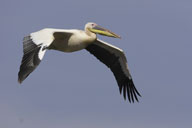
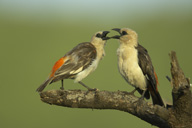


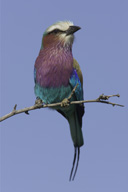
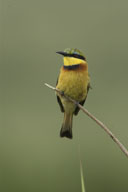

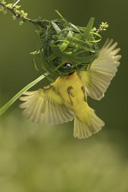
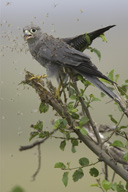
Above, top: African white pelican, white-headed buffalo
weaver, lesser flamingo.
Above, middle: Amur falcon, lilac-breasted roller, little
bee-eater.
Above, bottom row: Black-necked heron with lizard, Vitelline's
masked weaver building a nest,
gray kestril eating termites.
Below: white-backed vulture, lesser flamingo, Nubian vulture.
All images are an equal mix of Mary's and Joe's shooting.
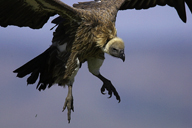
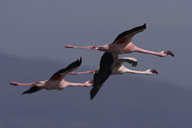
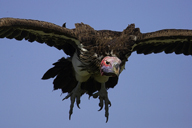
Caption: During a great vulture shoot, as scores
of vultures flew directly at our cameras, we
did something different. The shooters in my vehicle had a 'contest'
to see who caught
the definitive vulture image. That evening we added each of our
four images to my
laptop and did a show. It was a lot of fun -- the winner didn't
matter to any of us, but
it did motivate everyone to want to shoot more vultures! It was
also the genesis
of something new we'll do in the future -- an end of the safari
portfolio that we'll
do on our last evening. We did that this year and it was a huge
hit!
The mammal shooting was sensational.
Although all trips generally see all the animals one would expect,
and these two trips certainly did, we also did exceptionally well
with the cats. On the first safari we had 178 lion sightings,
8 leopards, and 34 cheetahs. The second safari didn't do as well
... only 173 lions, but we did have 12 leopards and 34 cheetahs!
Both trips had rhinos (both white and
black), including a mother and calf black rhino on S1 and a male
black rhino that did a short charge at our vehicle on S2. Elephants
were especially good at Samburu, a particularly fortuitous fact
since heavy rains hit Samburu after we left Samburu on S1, 'greening'
up the park and surrounding areas which could draw elephants outside
the park. The rains ended before we returned to Samburu on S2,
and the elephants were back, and we had some great river crossings
on both trips. Each safari is different and unique, and our elephant
experiences certainly illustrate this clearly. On the first safari
the Usao Nyiro River was low, and elephants waded, bathed, and
splashed effortlessly in the shallow water. On the second safari
the water level was much higher, and a whole new set of behaviors,
including determined, purposeful crossings of the high water were
the norm.
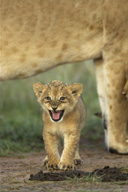
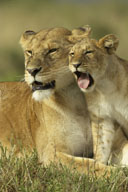
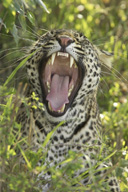

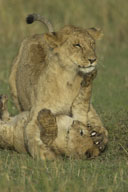

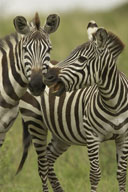
Each year the shooting only seems to
get better, and I think one reason for this is our continual urging
for photographers to simply be patient. If you 'let it happen'
chances are it will happen, and you'll be rewarded with behavior
and action, and not just 'record shots' or static images. Our
first safari was wonderful, and when we recapped the trip at our
final meal everyone stressed how important and instructive it
was to simply be patient and let things develop. I told the group
that I wished I could tape record their comments to play to our
next group, so that they would hear from others the importance
of that message. As it was, our advice was enough, and the second
group was equally patient, and the results certainly showed.
Most of our shooting (95% or more) is
done from the vehicles, with the only exception being the water
birds at Nakuru and any reptile/bird shooting we may do at the
lodges. There's not much of that for us, as downloading and keeping
up with editing digital files eat up a lot of our free time (see
Tip of the Month for my thoughts on digital storage for a safari)!
Both Mary and I used Molar
bags for shooting out of our vehicle's
windows, and Vested Interest and/or Kinesis bean bags for shooting
on top. One or two shooters used Molar bags on the roof top, and
this works, provided you sit the bag just right. One shooter had
trouble with this, prompting me to add this reminder that a Molar
bag is designed for window use primarily. Although I carried a
groofwinpod on the first safari, thinking I might use that as
well, the Molar bag was just too handy, flexible, and useful.
I am completely sold on it.
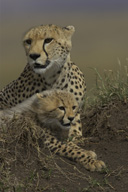
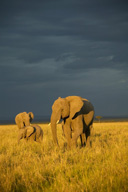
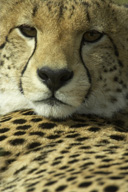
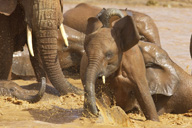
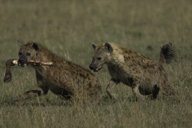
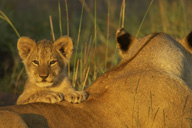
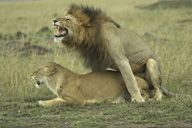
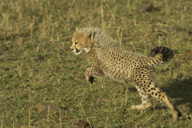
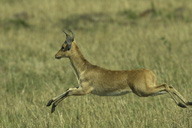
If you look at this portfolio
and think, 'wow, what action!' please
keep in mind that every one of these images was made on these
two safaris, with two other photographers in both Mary and my
landrovers. Most likely, those other four shooters have similar,
or better, images, as no doubt did the shooters that were not
in our vehicle on any given occasion. These shots represent both
opportunity -- being with our subjects, being patient, and being
alert, and readiness -- having our gear up and ready so that when
peak action happened we were ready to snap. It was, it is, as
easy as that!

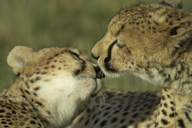

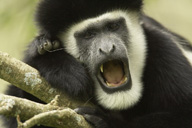
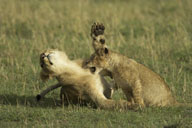
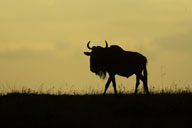
And, as I said earlier, PATIENCE
is the key. Sometimes action occured
fairly quickly. For example, the leopard kill began when one of
our vehicles spotted a mother leopard with her nearly-grown cub
sitting on a log just yards from a game track. They stayed long
enough for several of us to get some poses, then disappeared into
the brush. We kept looking for them, hoping for more shots, when
the excited alarm barks of a troop of vervet monkeys told us they,
at least, knew where the leopards where. As it turned out, the
mother leopard had surprised a monkey away from good cover and
had 'treed' it at the top of a 10-12 feet tall bush. For about
10 minutes the leopard circled the bush, attempting periodically
to climb through the dense shrub without success. Pretty easy
to wait on something like this, and worth it, too, for the leopard
finally lost patience and in a lightning move sprang to the top
of the brush and snatched the monkey. Seconds later we were there,
too, filming the cat as it dragged the monkey into the brush.
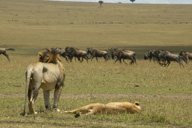

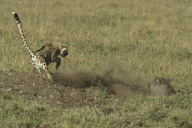

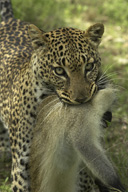
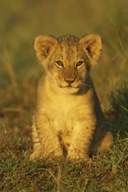
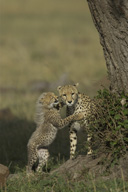
One day we encountered a mother cheetah with three nearly grown
young as they were hunting. Nothing was in sight so, after a few
minutes of shooting, we continued on to a lion kill where we later
photographed scores of vultures swooping in to the carcass (see
top images on this page). We left the cheetahs because we had
filmed more than 25 by this time in the trip, by the way! Later,
after the activity with the lions and vultures had finished, we
returned to the cheetahs where we watched the cheetahs chase a
family of warthogs into an abandoned burrow. Warthogs are tough,
no-nonsense critters, and we were not surprised when the warthogs
decided they had had enough and came charging straight out of
the burrow and began chasing the cheetahs. The image in the upper
right, above, shows one of the cheetahs as it jumps back in surprise
as the warthog begins its chase.
Likewise, our lion shooting was so worthwhile because we stayed
with the cats until the shooting was finished. There's no point
in leaving a great subject, as you really never know if you'll
find anything else to shoot. A cat-in-the-hand, or an eagle, or
an elephant, or whatever the photo subject is, if it's a worthwhile
subject it generally pays to stay with it until all the shooting
opportunities are exhausted. It pays off.


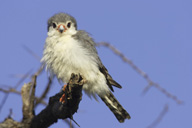
Caption: an African fish eagle feeding on a gnu carcass,
an immature Batelur eagle, Africa's
smallest falcon, the Pigmy falcon -- barely larger than a sparrow.
And speaking of eagles! Birds of prey are fairly easy to shoot,
and on both safaris photographers photographed martial, Batelur,
tawny, steppe, and African fish eagles, and some groups had black-chested
snake and brown snake eagles, too, in addition to African swallow-tailed
kites, shikras, black kites, augar buzzards, pallid and African
marsh harriers, Gabar goshawks, dark chanting and pale chanting
goshawks, and more.
I was lucky enough to get a gnu river-crossing with the folks
in my vehicle on both trips -- a pretty lucky event this year
since the migration was 'normal' and most of the herds had moved
south by the second safari. Sometimes river crossings require
hours of waiting, but this year we literally drove up to the river
as two of the three crossings were about to occur. The third crossing
did require a five minute wait, however.
Next summer Mary is having some neck surgery and because of
the recovery period we had anticipated not going to Kenya next
fall. But we can't help ourselves ... the shooting is too good.
As I write this, less than a week after returning home, we do
not have our dates set for next year, but we do anticipate doing
either one 19 day safari, or two back-to-back 14 day safaris beginning
in late October or early November. If you are interested, please
contact our office to get on our first-alert notification list.
We do anticipate the trips filling quickly.
Contact us by e-mail: info@hoothollow.com
Or Call or FAX us at: (717) 543-6423.













































